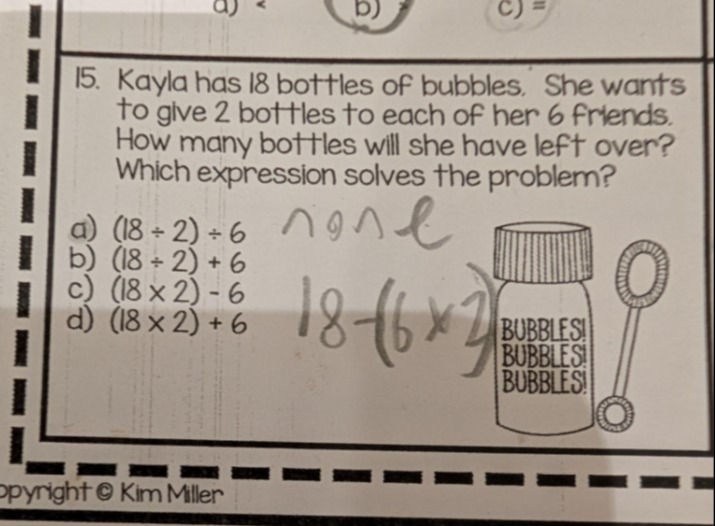A CONFUSED dad has been left stumped by his 10-year-old son’s maths homework with the internet dubbing it ‘absolutely bonkers.’
The father took to Reddit after being left puzzled by a multiple choice question given to his primary school-aged child.
While there are four different “answers” to choose from, the concerned dad noted there “must be missing something” from the equation – as none of the options appeared to be correct.
“This particular question was in my son’s math homework from the other day,” he wrote.
“They reviewed the answers in class today and apparently the answer was A.”
The question that has him, and everyone else, scratching their heads was this: Kayla has 18 bottles of bubbles. She wants to give two bottles to each of her six friends. How many bottles will she have left over?
Read More on Brainteasers
Children then had the option of four expressions and were challenged to identify the one that “solves the problem”.
It read: A) (18 divide 2) divide 6, B) (18 divide 2) + 6, C) (18 x 2) – 6, or D) (18 x 2) + 6.
But as the dad – who said he was “curious how they came to this answer” – pointed out, “none of the options seemed right as I was expecting it to be 18 – (6 × 2)”.
Some people rushed to the comments section to try and work out the answer, but most agreed there was an issue with the options provided with describing it as ‘absolutely bonkers’.
“I think it’s more likely a typo or misprint. If they swapped the subtraction and multiplication sign and moved the parentheses on answer choice C, then: (18 x 2) – 6 could become 18 – (2 x 6),” one said.
“You’re correct, the teacher is wrong. If you simplify A, you get 1.5 which doesn’t make any sense in the context of the problem,” mused another.
While one simply said: “Seems that A is wrong to me too.”
Some tried to make it work, but struggled.
“Really twisting my brain here to make sense of A being correct, but here goes: if you divide 18 bottles by 2 you get 9 bottles in two separate piles. Now give one bottle from each pile to all 6 friends. The result would be 3 bottles leftover in two separate piles, or 6 leftover bottles total. Gymnastics,” declared one.
“A, if they are supposed to use Euclidean divisions (18/2 = she has 9 batches of 2, 9/6 => 1 and remainder is 3),” tried another.
While one described it as “bad logic”, but gave it a stab anyway.
How can optical illusions and brainteasers help me?
Engaging in activities like solving optical illusions and brainteasers can have many cognitive benefits as it can stimulate various brain regions.
Some benefits include:
- Cognitive stimulation: Engaging in these activities challenges the brain, promoting mental agility and flexibility.
- Problem-solving skills: Regular practice enhances analytical thinking and problem-solving abilities.
- Memory improvement: These challenges often require memory recall and can contribute to better memory function.
- Creativity: They encourage thinking outside the box, fostering creativity and innovative thought processes.
- Focus and attention: Working on optical illusions and brainteasers requires concentration, contributing to improved focus.
- Stress relief: The enjoyable nature of these puzzles can act as a form of relaxation and stress relief.
“This is the only way I can get any of the answer choices (and it is A) – I’m not saying it’s correct, only wanted to explain their (wrong) logic:
“She’s splitting the 18 bottles into sets of 2, that’s 18 / 2. Then, she’s splitting those sets of 2 among her 6 friends.
“That’s why you divide by 6 next. That leaves you with A. But as everyone here has said, you and your son are correct. The worksheet is wrong.”
Eventually, the child decided to expose the issue with the question, writing: “None, 18 – (6 x 2).”
The father later returned to update everyone, stating “the worksheet is indeed wrong”.
“I did talk with the teacher and they went over it in class together. The teacher mentioned none of the answers were right and what my son came up with was correct,” he shared.
This article was originally published on News.com.au and has been republished here with permission.
